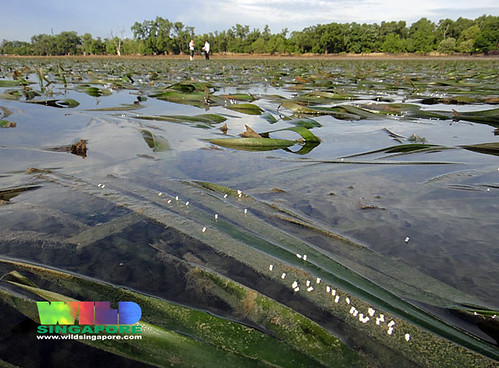Jose Hong, Straits Times AsiaOne 29 Dec 16;

The small white dots on the seagrass blades are the male flowers, and many of them have not been spotted for at least three to four years. A lack of sexual reproduction could endanger seagrass populations, which are effective at storing carbon, and are key feeding grounds in Singapore waters for sea animals such as dugongs.
Photo: RIA TAN
Most of Singapore's seagrass have not been sexually reproducing for at least three to four years, and worried scientists are working to find out what is wrong.
A lack of sexual reproduction - creating new plants through flowers and seeds - could lead to decreased genetic diversity in seagrass populations here, making them more vulnerable to mass die-offs.
This would harm the environment in many ways, as seagrass meadows are up to 30 times as effective as rainforests at storing carbon, and are key feeding grounds in Singapore waters for sea animals such as dugongs.
Hidden by the waves and frequently overshadowed by more colourful coral reefs, seagrass meadows dot the shores and seas around the country (see map).

Like much of the country's natural heritage, they have been in decline for decades, with around 40 per cent of the original cover lost to coastal development.
Singapore has 12 seagrass species, out of 23 in the Indo-Pacific region, according to the National Parks Board (NParks).
Since 2007, scientists and volunteers have regularly monitored them to check on their health.
As an aside to their actual survey work, they would frequently see seagrass producing fruits and flowers.
Dr Siti Maryam Yaakub, 35, led many of these trips, and said that because Singapore is a tropical country, seagrass should flower and bear fruit all year round.
"We would expect to see them at almost every low tide."
But around three to four years ago, the senior marine ecologist at environmental consultancy firm, DHI Water and Environment, started noticing that most of the flowers and fruits had simply stopped appearing.
Seagrass populations can grow by cloning themselves, and long-term surveys have indeed seen certain meadows increasing in size, such as those at Chek Jawa on Pulau Ubin.
But Dr Siti said this clonal growth - if it is indeed what Singapore's seagrass are doing could mean all the new seagrass are equally vulnerable to stressors like disease, making it more likely for entire new populations to die at the same time.
Furthermore, without seeds lying around in the environment, it would be much harder for new plants to return.
Ms Samantha Lai, a PhD candidate at the Experimental Marine Ecology Lab at the National University of Singapore (NUS), said there was already one such case on the shores of Pulau Semakau.
In 2009, a seagrass meadow off the island suddenly died, and aside from a few scattered patches of seagrass, the area remains barren, she said.
Ms Lai said environmental factors were also to blame, but added that one of the consequences of not having enough sexual reproduction "is not having enough seedlings or seeds to help the recovery of Semakau".
Dr Siti described the study of seagrass as "very nascent", and admitted there is still so much that researchers do not understand, but they are "working very hard to fill in many of these gaps".
This is the aim of their current research, which involves NParks in collaboration with NUS and DHI.
Dr Karenne Tun, director of the National Biodiversity Centre (Coastal and Marine) at NParks, said the three-year research project, which ends in the middle of 2018, intends to better understand the dispersal patterns of seagrass, in addition to assessing how resilient they are when faced with various stressors.
"Through the assessment of the status, connectivity and productivity of seagrass meadows in Singapore, we will be able to formulate measures for the conservation of seagrass, including the restoration of habitats for them," she said.
Said Dr Siti: "We are only scratching the surface in understanding what makes seagrass tick.
"Filling these gaps in our knowledge is the best chance we have of ensuring their continued survival."
Growing problem for Singapore's seagrass
posted by
Ria Tan
at
12/30/2016 10:25:00 AM
![]()
labels marine, seagrasses, shores, singapore, singapore-biodiversity, singapore-marine, southern-islands




